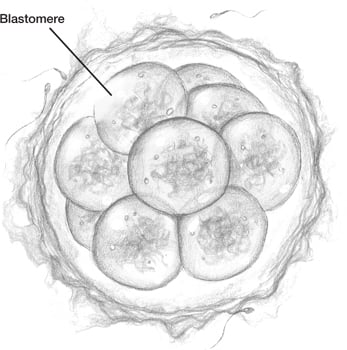1. How Big Is Your Baby?
The
embryo is very small—at this point, it’s only a group of cells, but it’s
growing rapidly. It’s the size of the head of a pin and would be
visible to the naked eye if it weren’t inside you. The group of cells
doesn’t look like a fetus or baby. During this first week, the embryo is about 0.006 inch (0.150mm) long.
2. How Big Are You?
In this third
week of pregnancy, it’s too soon to notice any changes. Few women know
they have conceived. Remember, you haven’t even missed a period yet.
3. How Your Baby Is Growing and Developing
Fertilization is the joining together of one sperm and an egg. We believe it occurs in the middle part of the Fallopian tube, called the ampulla, not inside the uterus. Sperm travel through the uterine cavity and out into the tube to meet the egg.
When the sperm and egg join, the sperm passes through the outer layer of the ovum, the corona radiata, then digests its way through another layer of the egg, the zona pellucida. Although several sperm may penetrate the outer layers of the egg, usually only one sperm enters the egg
and fertilizes it. The membranes of the sperm and egg unite, enclosing
them in the same membrane or sac. The egg reacts by making changes in
the outer layers so no other sperm can enter.
Once the sperm gets inside the egg, the head of the sperm enlarges and is called the male pronucleus; the egg is called the female pronucleus. The chromosomes of the male and female pronuclei intermingle.
When this happens, extremely small bits of
information and characteristics from each partner are combined. This
chromosomal information gives each of us our unique characteristics. The
usual number of chromosomes in a human being is 46. Each parent
supplies 23 chromosomes. Your baby is a combination of chromosomal
information from you and your partner.
The developing ball of cells is called a zygote.
The zygote passes through the uterine tube on its way to the uterus;
the division of cells continues. These cells are called a blastomere. As the blastomere divides, a solid ball of cells is formed, called a morula. Gradual accumulation of fluid within the morula results in the formation of a blastocyst.
During the next week, the blastocyst
travels through the uterine tube to the uterus (3 to 7 days after
fertilization in the tube). The blastocyst lies free in the uterine
cavity as it continues to grow and to develop. About a week after
fertilization, it attaches to the uterine cavity (implantation), and
cells burrow into the lining of the uterus.
4. Changes in You
Some women can tell when they ovulate.
They may feel mild cramping or pain, or they may have an increased
vaginal discharge. Occasionally when the fertilized egg implants in the
uterine cavity, a woman may notice a small amount of bleeding.
Boy or Girl?
Your baby’s sex is determined at the time
of fertilization by the type of sperm (male or female) that fertilizes
the egg. A Y-chromosome sperm produces a boy, and an X-chromosome sperm
produces a girl.

Nine-cell embryo 3 days after fertilization.
The embryo is made up of many blastomeres;
together they form a blastocyst.
It’s too early for you to notice many changes. That lies ahead!
5.How Your Actions Affect Your Baby’s Development
Aspirin Use
We advise caution with the use of aspirin
because it can increase bleeding. If you take aspirin during pregnancy,
your baby may be at higher risks for some problems.
Studies show aspirin and nonsteroidal
anti-inflammatory medications (NSAIDs), such as Advil, Motrin and Aleve,
may increase the risk of miscarriage. When taken soon after conception,
the risk is highest. Aspirin also causes changes in blood clotting.
This is important to know if you bleed during pregnancy or if you’re at
the end of pregnancy and close to delivery.
Read labels on any medicine you take to
see if it contains aspirin. Some OTC antidiarrheal medications have it.
It’s also important to watch your salicylate intake. Salicylate is
contained in Pepto-Bismal, Kaopectate and some skin products.
If you need a pain reliever or fever
reducer and can’t reach your healthcare provider for advice,
acetaminophen (Tylenol) is an over-the-counter medicine you can use for a
short while with little fear of problems for you or your baby.
In some cases, small doses of aspirin may
be acceptable during pregnancy. However, don’t take any aspirin without
discussing it with your healthcare provider first!
Taking Aspirin during Pregnancy
There may be situations in which aspirin
use is helpful and may be good insurance against some pregnancy
problems. Talk to your healthcare provider, if you have questions.